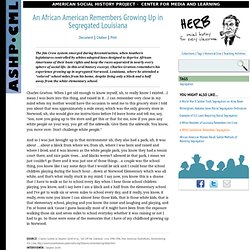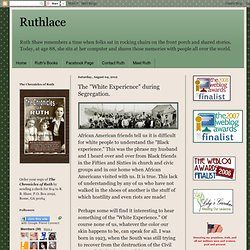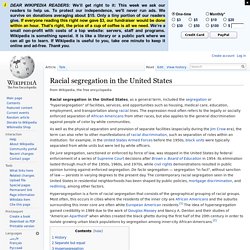

Growing up as a black child during the black segregation. An African American Remembers Growing Up in Segregated Louisiana The Jim Crow system emerged during Reconstruction, when Southern legislatures controlled by whites adopted laws designed to deprive African-Americans of their basic rights and keep the races separated in nearly every sphere of social life.

In this oral history excerpt, Charles Gratton remembers his experience growing up in segregated Norwood, Louisiana, where he attended a "colored" school miles from his home, despite living only a block and a half away from the white elementary school. Source | Charles Gratton to Stephen Smith et al., "Get Off the Sidewalk," circa 1994-1996, from American RadioWorks, Remembering Jim Crow, | Stephen SmithInterviewee | Charles GrattonRights | Transcripts from "Remembering Jim Crow," an American Radioworks ® documentary produced by Stephen Smith, Kate Ellis and Sasha Aslanian, © (p) 2001 American Public Media. Used with permission. The "White Experience" during Segregation. African American friends tell us it is difficult for white people to understand the "Black experience.

" This was the phrase my husband and I heard over and over from Black friends in the Fifties and Sixties in church and civic groups and in our home when African Americans visited with us. It is true. This lack of understanding by any of us who have not walked in the shoes of another is the stuff of which hostility and even riots are made! Perhaps some will find it interesting to hear something of the "White Experience. " Of course none of us, whatever the color our skin happens to be, can speak for all. In our town many Caucasian workers worked from "sunup to sundown," twelve hour days for a meager living in one of the textile mills or anywhere they could find employment.
Cotton farmers all over the South during the Great Depression and the Boll weevil epidemic were giving up on trying to make a living in farming. Sad to say, we each had our own schools and churches. As G.K. Martin Luther King, Jr. Have you heard of Martin Luther King, Jr.?

Every year on the third Monday of January, we have a holiday. It's called Martin Luther King, Jr. Day. Martin Luther King, Jr. was a famous man. Learn more about him. Vocabulary races/ racial- groups of people based on looks (skin color) and background, for example- white people, Asian people, black people, etc. to segregate/ segregation- dividing into groups, usually talking about race, for example- black people and white people didn't go to the same schools and lived in different neighborhoods minister- leader of a church rights- freedoms, what you are allowed to do. Rosa Parks. On December 1, 1955, Rosa Parks, a 42-year-old African American woman who worked as a seamstress, boarded this Montgomery City bus to go home from work.

On this bus on that day, Rosa Parks initiated a new era in the American quest for freedom and equality. She sat near the middle of the bus, just behind the 10 seats reserved for whites. Soon all of the seats in the bus were filled. When a white man entered the bus, the driver (following the standard practice of segregation) insisted that all four blacks sitting just behind the white section give up their seats so that the man could sit there.
Mrs. Black segregation Africa (Apartheid) During most of the 20th century, South Africa was ruled by a system called Apartheid, which was based on the segregation of races.

When did Apartheid start? The term Apartheid was introduced during the 1948 election campaign by DF Malan's Herenigde Nasionale Party (HNP - 'Reunited National Party'). But racial segregation had been in force for many decades in South Africa. School Enrollment in Apartheid South Africa. Racial segregation in the United States. Racial segregation in the United States, as a general term, included the segregation or "hypersegregation" of facilities, services, and opportunities such as housing, medical care, education, employment, and transportation along racial lines.

School segregation. Minorities account for nearly half of the student population in America, and will likely become the majority within the next decade or two, but recent studies show that students across the country are still largely learning in segregated environments -- along both racial and economic lines.

According to a new analysis of data from the U.S. Department of Education, an overwhelming majority of Latino and black students study in racially isolated classrooms: 80 percent of Latino students and 74 percent of black students are in schools where the majority of students are not white. More specifically, 43 percent of Latinos and 38 percent of black attend "intensely segregated schools" where white students comprise 10 percent or less of the student body. "These trends threaten the nation's success as a multiracial society," Civil Rights Project Co-Director Gary Orfield said in a statement Thursday.
Jim Crow Laws. Jim Crow was a character in an old song who was revived by a white comedian called Daddy Rice.

Rice used the character to make fun of black people and the way that they spoke. The term Jim Crow came to be used as an insult against black people. In a bid to stop black Americans from being equal, the southern states passed a series of laws known as Jim Crow laws which discriminated against blacks and made sure that they were segregated (treated unequally) from whites. Image copyright Jim Crow Museum A black man, Homer Plessey, took a railroad company to court because he had been made to sit in a 'coloured only' carriage. The Rise and Fall of Jim Crow . Jim Crow Stories . Segregation in the U. S. Government. In 1912 Woodrow Wilson, the Democratic candidate for president, promised fairness and justice for blacks if elected.

In a letter to a black church official, Wilson wrote, "Should I become President of the United States they may count upon me for absolute fair dealing for everything by which I could assist in advancing their interests of the race. " But after the election, Wilson changed his tune. He dismissed 15 out of 17 black supervisors who had been previously appointed to federal jobs segregating their departments. Throughout the country, blacks were segregated or dismissed from federal positions.